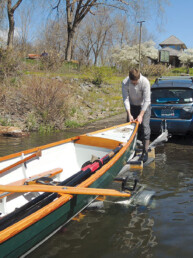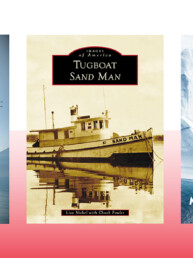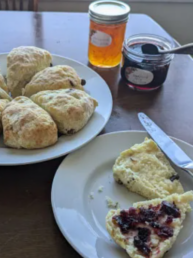An inevitable purchase finally happened for the crew of Yahtzee. After owning our beloved home for over six years and doing a substantial amount of cruising, we finally got two things we’ve never had before: a rigid-hulled inflatable dinghy (RIB) and an outboard engine.

Some may wonder how it took so long, and the truth is that it was a combination of being content with what we’ve made work and price. Our first dinghy came with Yahtzee. It was an awkwardly rowing inflatable with a soft floor and no real transom to mount an engine. We always knew that it wouldn’t be suitable for more than two adults so when we got our family kayak (two adult seats, one child’s seat), we found the inflatable a better home.


The kayak then became our sole landing craft and has worked exceptionally well over many years, miles and adventures. Surprising well, actually. As our family grew, though, it too could only take us so far. Next came the 8-foot sailing and rowing dinghy to help carry our four-person crew. It has also proven to be sufficient, and is super fun to sail. Then came our standup paddleboard, which was a great addition to the fleet as well.

The thing about all these tenders is that, in the Pacific Northwest, we’ve rarely had to travel very far from where Yahtzee was anchored to shore — which is a luxury compared to many cruising grounds around the world. Sure, have there been times when we could have zipped 10 to 20 miles in a fast dinghy to a glacier, beach or even a grocery store? The honest answer is yes. But we couldn’t, until now.
With the boys getting physically larger and our cruising plans evolving to Alaska and beyond (yes, south!), we finally gave in to what we’ve always known: our family will greatly benefit from a boat that can safely hold us all and travel farther and faster. Happily, we’re already enjoying the fruits of our decision.

What we did and did not want:
The learning process about powerboats and dinghies started when my grandmother first taught me to drive one (I think I was about 10). Years of experience cruising on the east coast and in Florida, the Bahamas and Caribbean then refined my thoughts on what I wanted in a proper tender — and since that time Jill and I have used many different types and have researched many others. After all, a dinghy is a cruiser’s “car”, which means buying one isn’t a task that should be taken lightly. It’s also a task that is different for every boater, as you have to know what your specific constraints and needs are.
Our list of requirements for a new tender were:
- Had to be a RIB (Rigid-hulled Inflatable Boat); aluminum preferred, no inflatable hulls or wooden floors
- Had to have Hypalon tubes over PVC (Hypalon is more durable and weather resistant)
- Had to fit at least four adults with a modest amount of gear
- Had to be less than 10 feet to fit on Yahtzee’s foredeck
- Had to have an engine to get the boat on plane
What we got: The path to the dinghy we actually bought came with remarkable ease and timing. Had it not, we’d still be looking. When I found out that my friend and fellow editor at Three Sheets, Marty, was getting ready to buy a dinghy at an auction last fall in Seattle, I texted to let him know we were interested. Knowing that Marty’s list of requirements paralleled ours, I hoped we could both come away with something at a fair price.
Sure enough, Marty scored. He came home with two brand new dinghies still in their original packaging, and Jill and I bought one. As luck would have it, the new dinghy literally ticked every box on our list of requirements. It’s a 9-foot, aluminum-hulled AquaPro that holds our family and more.
Then, when I was down in Seattle in January for the boat show, I arranged for it to be put on a ship in Tacoma and sent to Anchorage. Easy as that. Later that weekend out of sheer curiosity while at the show, I walked around looking at dinghies that had the same specs as ours. To my pleasant surprise, I learned that we paid half the amount of a similar “boat show priced” dinghy.
After our new boat’s journey to Alaska, we finally dropped her in the water and, thus far, we’re very happy with the boat and engine.

Engine-wise, we tend to agree with our good buddy Sam Landsman of Slowboat.com, who lives by the mantra, “Slow boat, fast dinghy.” Meaning a relatively slow moving liveaboard cruiser like a sailboat or trawler is enhanced with a fast dinghy as a car. In our minds, and experience, if you’re going to buy a RIB, it has to be pushed by an engine that can really make it get-up-and-go. It has to plane.

For us, that meant electric outboards were out, so too were the tiny 2.5 hp outboards that barely get the boat moving, let alone up on plane. A 6 hp engine would probably get the boat going with one or two people aboard, but with four, plus gear and provisions, the obvious choice was to go with a 9.9 hp or more.
At first I looked at new engines, but then realized that we lived in a place where used 9.9 hp outboards are actually readily available. Many local fisherman use them as “kickers” on their boats, and when I went searching through Craiglist and on the Facebook Marketplace, I quickly found exactly what I was looking for: an early 90s two-stoke Johnson 9.9. These engines are timeless, relatively light, easy to work on and, as a mechanic friend put it, “those engines are bulletproof.”
After a Facebook live video of the engine running, I met the owner and took it off his hands for a screaming deal. Once again, easy as that. And I’m happy to report that the engine purrs like a kitten, runs smooth as a top and turns our new dinghy into an absolute speed demon. Also, it’s the same type of engine I learned on with Grandmom all those years ago — a perfect ending.
Andy Cross
Andy Cross is the editor of 48° North. After years cruising the Pacific Northwest and Alaska with his family aboard their Grand Soleil 39, Yahtzee, they sailed south and are currently in the Caribbean Sea. You can follow their adventures at SailingYahtzee.com.






